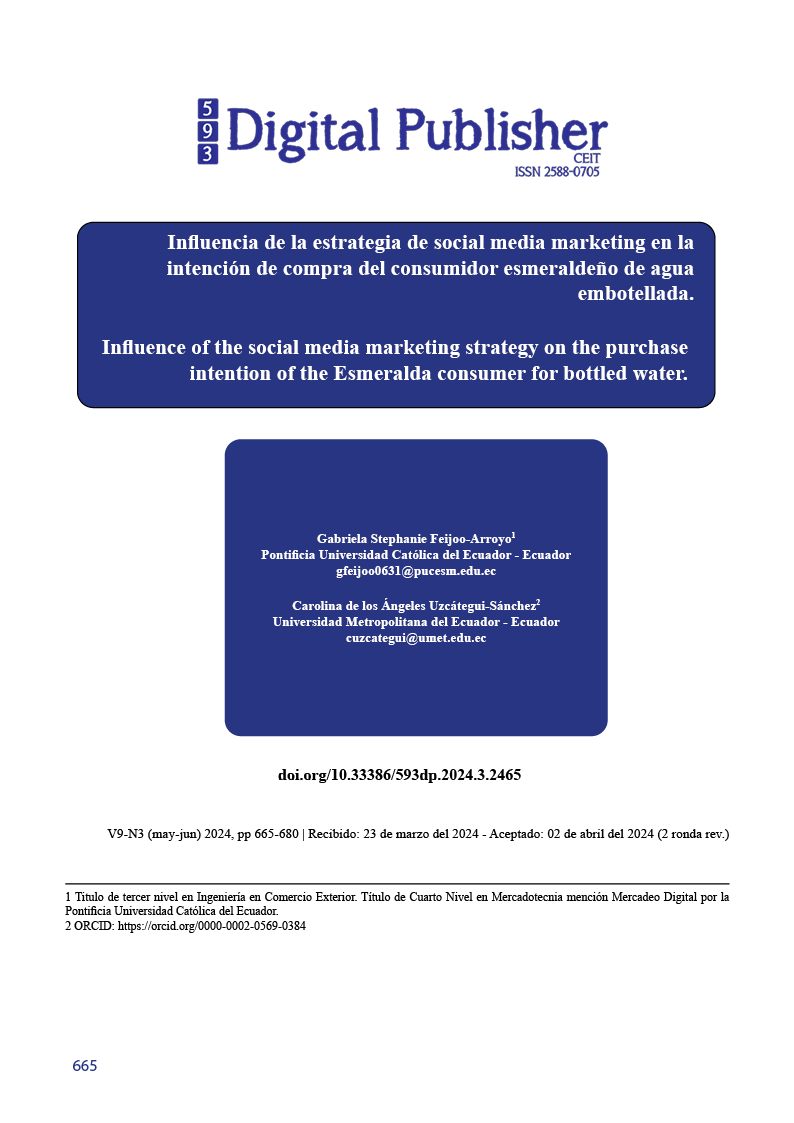Influencia de la estrategia de social media marketing en la intención de compra del consumidor esmeraldeño de agua embotellada
Contenido principal del artículo
Resumen
Este trabajo investiga la influencia de la estrategia de social media marketing en la intención de compra del consumidor esmeraldeño de agua, aborda el contenido generado por la empresa, por el usuario en redes sociales y el eWOM, resaltando su importancia para acercarse al cliente y generar interés en los productos y servicios. Se menciona la relevancia de las redes sociales en el ámbito publicitario y cómo estas pueden influir en la intención de compra del consumidor.
Se llevó a cabo una recolección de datos a través de un cuestionario diseñado para medir las variables de interés. Utilizando esta información, se desarrolló un modelo de regresión lineal que permitió estimar la influencia de estas variables en la intención de compra de agua embotellada de marca Nativa. Los resultados obtenidos revelaron que el contenido generado por los usuarios y la comunicación electrónica boca a boca (ewom) tienen un impacto positivo y significativo en la intención de compra de la marca.
Descargas
Detalles del artículo

Esta obra está bajo una licencia internacional Creative Commons Atribución-NoComercial-CompartirIgual 4.0.
1. Derechos de autor
Las obras que se publican en 593 Digital Publisher CEIT están sujetas a los siguientes términos:
1.1. 593 Digital Publisher CEIT, conserva los derechos patrimoniales (copyright) de las obras publicadas, favorece y permite la reutilización de las mismas bajo la licencia Licencia Creative Commons 4.0 de Reconocimiento-NoComercial-CompartirIgual 4.0, por lo cual se pueden copiar, usar, difundir, transmitir y exponer públicamente, siempre que:
1.1.a. Se cite la autoría y fuente original de su publicación (revista, editorial, URL).
1.1.b. No se usen para fines comerciales u onerosos.
1.1.c. Se mencione la existencia y especificaciones de esta licencia de uso.
Citas
Aguirre S., Ruiz M., Rodríguez A. (2021). El rol del eWOM en la comunicación de RSC en redes sociales. Anagramas Rumbos y Sentidos de la Comunicación vol. 19 issue 38 pp: 11-33 Published by Universidad de Medellín. http://www.scielo.org.co/scielo.php?script=sci_arttext&pid=S1692- 25222021000100011#:~:text=El%20eWOM%20alude%20a%20cualquier,et%20al.%2 C%202004).
Anda Chavarria, C. M. (2015). ANÁLISIS SOBRE PARTICIPACIÓN Y POSICIONAMIENTO DE MARCAS DE AGUA EMBOTELLADA EN LA CIUDAD DE
MILAGRO (Bachelor's thesis). http://201.159.223.2/bitstream/123456789/534/1/ANALISIS%20SOBRE%20PARTICI PACION%20Y%20POSICIONAMIENTO%20DE%20NARCAS%20DE%20.pdf /
Andrade Yejas, D. A. (2016). Estrategias de marketing digital en la promoción de Marca Ciudad. Revista ean, (80), 59-72. https://www.redalyc.org/journal/206/20645903005/html/
Barricarte, M. A. (2021). Electronic Word of Mouth (eWOM) and Marketing Implications (Doctoral dissertation, Universidad Pública de Navarra). https://academica- e.unavarra.es/xmlui/bitstream/handle/2454/41237/Tesis%20Alzate%2c%20Miriam.pdf? sequence=1&isAllowed=y
Bernal-González, I., Barboza-Alonso, A. M., & Flores-Flores, A. J. (2023). Las redes Sociales como estrategia de marketing digital: Un análisis bibliométrico. Vinculatégica EFAN, 9(6), 16-
https://www.researchgate.net/publication/376301217_Las_redes_Sociales_como_est rategia_de_marketing_digital_Un_analisis_bibliometrico
Caballero, R. J. P., & Lara, O. M. N. (2021). Las redes sociales como estrategia de marketing en las pequeñas y medianas empresas del distrito de Aguadulce, provincia de Coclé, Panamá. Visión Antataura, 5(2), 115-131
Calle, M., & Torres, C. (2023). Impacto de la calidad y valor percibidos sobre la intención de compra: sector automotriz. Ciencias Sociales Y Económicas, 7(1), 12–23. https://doi.org/10.18779/csye.v7i1.645
Carrasco Medina, R., & Villanueva Erazo, M. D. C. (2023) Efecto del eWOM en la intención de compra de los consumidores de moda sostenible en Lima Metropolitana. https://tesis.pucp.edu.pe/repositorio/bitstream/handle/20.500.12404/24907/CARRASC O_MEDINA_VILLANUEVA_ERAZO%20%281%29.pdf?sequence=1&isAllowed=y
Chavez, A. A., & Bonilla Vásquez, G. (2017). La Importancia de las Redes Sociales en El Marketing de una Compañía. Espíritu Emprendedor TES, 1(2), 1–8. https://doi.org/10.33970/eetes.v1.n2.2017.5
Córdoba, F. G. (2005). El cuestionario: recomendaciones metodológicas para el diseño de cuestionarios. Editorial Limusa. https://books.google.es/books?hl=es&lr=&id=- JPW5SWuWOUC&oi=fnd&pg=PA7&dq=EL+cuestionario+EN+ARTICULO+CIENTI FICO&ots=fevxAmvidP&sig=i6uxWQGMBsBxFCEoQd32XetmMvA#v=onepage&q &f=false
Domínguez Grandez, E. B. (2020) El eWOM positivo, reconocimiento de marca, y su impacto en la intención de compra a través de la red social Instagram en los restaurantes de comida Nikkei en la ciudad de Lima. https://repositorioacademico.upc.edu.pe/bitstream/handle/10757/651930/Dom%c3%adn guez_GE.pdf?sequence=4&isAllowed=y
Ercolani Álvarez, V. (2023). Contenido generado por el usuario (CGU): análisis de la presencia de la marca Gucci en la música urbana. https://uvadoc.uva.es/bitstream/handle/10324/60714/TFG- N.%202071.pdf?sequence=1&isAllowed=y
Garzón Medina, C., Forero Molina, S. C., Pineda Ríos, W. D., & Lopera Marín, A. (2021). Influencia de los anuncios publicitarios en redes sociales en la respuesta emocional y la intención de compra de bebidas lácteas funcionales. Interdisciplinaria, 38(2), 167-182. https://www.redalyc.org/articulo.oa?id=18066677011
Guevara Alban, G. P., Verdesoto Arguello, A. E., & Castro Molina, N. E. (2020). Metodologías de investigación educativa (descriptivas, experimentales, participativas, y de investigación-acción). RECIMUNDO, 4(3), 163-173. https://doi.org/10.26820/recimundo/4.(3).julio.2020.163-173
Hernández, R., Fernández, C., & Baptista, M. (2014). Metodología de la investigación. Mc Graw Hill. https://www.esup.edu.pe/wp- content/uploads/2020/12/2.%20Hernandez,%20Fernandez%20y%20Baptista- Metodolog%C3%ADa%20Investigacion%20Cientifica%206ta%20ed.pdf
Ivanova, M. Q. E. (2021). Percepción Y Consumo Del Agua Embotellada Y Calidad De Servicio De Agua Potable En La Ciudad De Esmeraldas (Doctoral dissertation, Ecuador-PUCESE-Escuela de Gestión Ambiental). https://repositorio.puce.edu.ec/server/api/core/bitstreams/0d80921f-a514-471d-8acf- 810fdb44c491/content
Kutchera, J., García, H., & Fernández, A. (2014). EXITO: su estrategia de marketing digital en 5 pasos. Grupo Editorial Patria. https://books.google.es/books?hl=es&lr=&id=1NjhBAAAQBAJ&oi=fnd&pg=PP1&dq
=estrategias+de+marketing+digital&ots=k18iijznb9&sig=3LamPvLh_8WAmI7WiIkw5 CjzH10#v=onepage&q=estrategias%20de%20marketing%20digital&f=false
FormaLópez Prado, L. (2022). La industria de la moda en TikTok: análisis del contenido publicado por las marcas versus contenido generado por usuarios: el caso de Zara. https://ruc.udc.es/dspace/bitstream/handle/2183/32128/LopezPrado_Leire_TFG_2022.p df?sequence=2&isAllowed=y
FormaLuque, F. V., Lozano, L. A. H., & Quiroz, A. F. B. (2018). Importancia de las técnicas del marketing digital. RECIMUNDO: Revista Científica de la Investigación y el Conocimiento, 2(1), 764-783. file:///Users/syslan/Desktop/Dialnet- ImportanciaDeLasTecnicasDelMarketingDigital-6732914.pdf
Luza, T. C., Córdova, O. J., Gonzáles, J. L. A., Limo, F. A. F., & Flores, C. A. B. (2023). Métodos mixtos de investigación para principiantes. Instituto Universitario de Innovación Ciencia y Tecnología Inudi Perú. file:///C:/Users/gabyf/Desktop/LIBRO106- Mtodosmixtosdeinvestigacinparaprincipiantes3.pdf
Maciá, F., & Gosende, J. (2011). Marketing en redes sociales. Anaya. España. https://books.google.es/books?hl=es&lr=&id=vtavEAAAQBAJ&oi=fnd&pg=PA5&dq
=redes+sociales+en+marketing&ots=Dff- sEcgkW&sig=C7w8ejf_7YRAyiv0RwkjdUPGSro#v=onepage&q=redes%20sociales% 20en%20marketing&f=false
Marketers United. (2023, octubre 24) Contenido generado por el usuario: Todo lo que debes saber. Linkedin. https://es.linkedin.com/pulse/contenido-generado-por-el- usuario-todo-lo-que-debes-saber-hy9ve
Martínez Dolera, F. El eWOM como herramienta de marketing digital. (2018) http://dspace.umh.es/bitstream/11000/7033/1/TFG%20Mart%C3%ADnez%20D%C3% B3lera%2C%20Francisco.pdf
Montalván Gutiérrez, J. D., & Gómez Soto, I. (2022). Efecto del boca oreja electrónico (eWOM) en la intención de compra de los usuarios de la red social Facebook en Colombia. https://red.uao.edu.co/server/api/core/bitstreams/39ce63b0-710a-491f-a5d3- d8f752ff01a0/content
Morales Valdivieso, A., & López-Mobilia de Bustamante, C. (2021). La influencia del marketing de contenidos en la decisión de compra de mujeres en productos saludables de biomarkets en Lima. https://repositorio.ucv.edu.pe/bitstream/handle/20.500.12692/113621/Fuster_SMYH- Horna_LKL-SD.pdf?sequen8ce=1&isAllowed=y
Pacheco Tamayo, E.M. (2001). El compromiso como antecedente de la lealtad del consumidor. (Tesis Doctoral Inédita). Universidad de Sevilla, Sevilla. https://www.scielo.org.mx/pdf/cya/v66n3/0186-1042-cya-66-03-00001.pdf
Panizo Coronado, G. S. (2022). La redes sociales y su relación con la intención de compra online en usuarios digitales de un cine de Lima Metropolitana en el 2019. https://repositorio.cientifica.edu.pe/handle/20.500.12805/2299
Quiroz Gallegos, E., & Tagle Smith, C. E. (2019). Marketing de redes sociales: la relación entre el contenido generado por la marca, el engagement y las ventas. https://tesis.pucp.edu.pe/repositorio/bitstream/handle/20.500.12404/15732/Quiroz%20G allegos_Tagle%20Smith_Marketing_redes_sociales1.pdf?sequence=1&isAllowed=y
Ramos, J. (2016). Marketing de contenidos. Guía práctica. XinXii. https://books.google.es/books?hl=es&lr=&id=bZI2DgAAQBAJ&oi=fnd&pg=PT2&dq
=contenido+generado+por+la+marca&ots=jSFyv0mvGM&sig=waw0BVrGeAhQJ_- Q0apeLBDMX2o#v=onepage&q=contenido%20generado%20por%20la%20marca&f=f alse
Rentería-García, J. C., Fajardo-Toro, C. H., & Sabogal-Salamanca, M. (2020). Contenido Generado por el Usuario y su Relación con la Confianza de Marca. Revista Ibérica de Sistemas e Tecnologias de Informação, (E34), 421-435. https://www.researchgate.net/profile/Carlos-Fajardo- Toro/publication/352666614_Contenido_Generado_por_el_Usuario_y_su_Relacion_co n_la_Confianza_de_Marca_Contenido_Generado_por_el_Usuario_y_su_Relacion_con
_la_Confianza_de_Marca/links/60d239d3299bf19b8d9d81f1/Contenido-Generado-por- el-Usuario-y-su-Relacion-con-la-Confianza-de-Marca-Contenido-Generado-por-el- Usuario-y-su-Relacion-con-la-Confianza-de-Marca.pdf
Romero, R. (2019). Intención de compra. Richard Romero. https://romerorichard.wordpress.com/2019/11/19/intenciondecompra/
Sanjaime Calvet, L. (2012). Redes sociales y marketing (Doctoral dissertation, Universitat Politècnica de València). https://riunet.upv.es/handle/10251/17406
Sologuren Verne, M. A. (2013). El social media marketing como estrategia para potenciar una empresa.
https://repositorioacademico.upc.edu.pe/bitstream/handle/10757/303411/sologuren_vm- pub-delfos.pdf?sequence=1&isAllowed=y
Sophia Schmid. noviembre 30, 2022. Contenido generado por el usuario - ¿Qué es?. Neuroflash. https://neuroflash.com/es/contenido-generado-por-el-usuario-una- estrategia-para-aumentar-el-compromiso/
Tinoco Egas, Juanatey Boga, Martínez Fernández, Generación de emociones en la intención de compra Revista de Ciencias Sociales (Ve), vol. XXV, núm. 3, 2019 Universidad del Zulia, Venezuela https://www.redalyc.org/articulo.oa?id=28060161018
Torres P., Padilla S., (2013). Medición de la intención de compra con base en un modelo de regresión logística de productos de consumo masivo. https://dspace.ups.edu.ec/bitstream/123456789/5772/1/UPS-QT03953.pdf
Torres, B. V. L., Espinoza, M. F. T., & Argoti, D. J. C. (2021). El marketing digital: herramientas y tendencias actuales. Dominio de las Ciencias, 7(6), 907-921. https://dialnet.unirioja.es/servlet/articulo?codigo=8383788
Torres, B. V. L., Espinoza, M. F. T., & Argoti, D. J. C. (2021). El marketing digital: herramientas y tendencias actuales. Dominio de las Ciencias, 7(6), 907-921. file:///C:/Users/gabyf/Desktop/Dialnet-ElMarketingDigital-8383788.pdf
Valarezo, J. M., Padilla, E. M., & Parra, A. M. (2022). Uso del social media marketing y el engagement en universidades de Machala. 593 Digital Publisher CEIT, 7(3), 230-
file:///Users/syslan/Desktop/Dialnet- UsoDelSocialMediaMarketingYElEngagementEnUniversid-8534722.pdf
Valencia, A., Palacios, I., Cedeño, J., & Collins, N. (2014). Influencia del marketing digital en el proceso de decisión de compra. Revista Científica Y Tecnológica UPSE, 2(1). https://doi.org/10.26423/rctu.v2i1.38
Velásquez, E., & Dinarès, M. (2011). El Comercio internacional de agua embotellada-la hidromafia. In Barcelona: Congreso Ibérico sobre Gestión y Planificación de Agua.
Obtenido de https://fnca.eu/images/documentos/VII%20C.IBERICO/Comunicaciones/A3/33- Velazquez.pdf A (Vol. 3).
Villanueva, J., & Armelini, G. (2012). El poder del boca-oreja en el marketing mix. Los consumidores hablan de ti. Revista de Negocios del IEEM, 15(5), 18-25. https://d1wqtxts1xzle7.cloudfront.net/32984381/articulo_BOCA_A_OREJA- libre.pdf?1393927806=&response-content- disposition=inline%3B+filename%3Darticulo_BOCA_A_OREJA.pdf&Expires=17109 56525&Signature=bJQ- 2WyBhEOv6uUsJZwMkGXguOh~RYaWaaG74T3mMu5~ixv97BX06tXRH5ikDlvlX 6NXq78vLwn~Qy69y8AyelfiH5dNmNUl8wywrssKQZ- Zw8F9~tANm4WL2nhkp0j9cfhBPUhDYjbVVZXQr3e6fCA79lagfF8X0j7aE2oak6WE fgTZIwQlFttP4aehUZFlNInoJqOg-6FXB- wAiyqdgNAemvyUPFKMo87RiqAZsxu6kGSXrfoX70QIBwt8DQWv9cUUg8exbGU QjmTbCwz61J~CfryrnI5sNFLBMbJ7t1sey5jEYx2-1jhjVcpC- L41UNLn49u06ka6PzfpV6mdxw &Key-Pair-Id=APKAJLOHF5GGSLRBV4ZA



